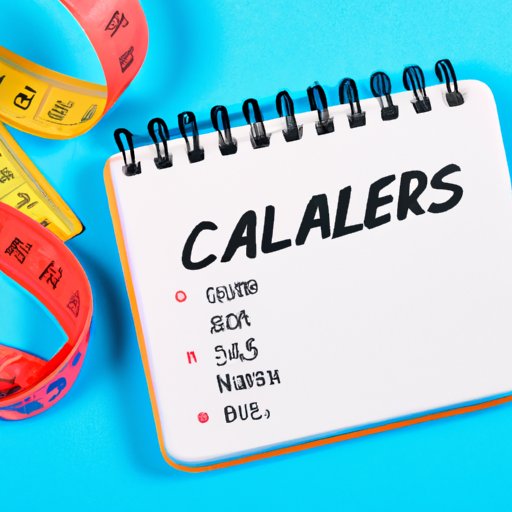I. Introduction
Understanding how many calories are in a fat gram is essential for making healthier food choices. Every day, people consume different types of foods that contain varying levels of calories and fat grams. Knowing this information can help individuals manage their diet and maintain good health.
II. The Science Behind Calories and Fat Grams
Calories are a unit of measurement used to determine the amount of energy in food. Fat grams, on the other hand, are a way to measure the amount of fat that a particular food contains. Because the body requires energy to function, calories and fat grams play an essential role in the way the body processes and uses food.
When we consume food, the body uses the calories from that food to fuel its daily activities. If we consume more calories than our body needs, the excess calories are stored as fat. Conversely, if we consume fewer calories than our body requires, we lose weight as the body uses stored fat as an alternative energy source.
There are nine calories in one gram of fat. In comparison, protein and carbohydrates contain only four calories per gram. This means fat is a high-calorie food, which makes it important to pay attention to the amount and type of fat consumed.
III. Listicle: Common Foods and Their Calorie and Fat Gram Contents
It’s important to make healthy food choices, and understanding the calorie and fat gram contents of common foods can be a helpful tool. Here are some popular foods and their calorie and fat gram contents:
Fruits and Vegetables:
- Apple (one medium): 95 calories, 0 grams of fat
- Banana (one medium): 105 calories, 0 grams of fat
- Carrots (one cup): 52 calories, 0 grams of fat
- Broccoli (one cup): 55 calories, 1 gram of fat
Meats and Dairy Products:
- Chicken Breast (three ounces): 140 calories, 3 grams of fat
- Salmon (three ounces): 175 calories, 10 grams of fat
- Ground Beef (three ounces): 250 calories, 20 grams of fat
- Cheddar Cheese (one ounce): 114 calories, 9 grams of fat
Grains and Snacks:
- Potato Chips (one ounce): 160 calories, 10 grams of fat
- Peanuts (one ounce): 160 calories, 14 grams of fat
- Popcorn (one cup): 30 calories, 0 grams of fat
- Brown Rice (one cup): 216 calories, 2 grams of fat
When making food choices, consider opting for lower-fat, higher-fiber, and high-protein foods. These types of foods can help you feel full longer, aid weight loss, and support overall health.
IV. The Impact of Consuming Too Many Calories or Too Much Fat on a Person’s Health
Consuming too many calories, particularly from high-fat foods, can lead to weight gain and an increased risk of developing chronic diseases such as heart disease, high blood pressure, and diabetes. It’s important to be mindful of the amount and type of fat consumed to maintain good health.
Reducing Calorie and Fat Intake:
- Avoid deep-fried, processed, or high-fat foods
- Choose lean protein sources such as chicken, fish, and legumes
- Incorporate healthy fats like avocado, nuts, and olive oil in moderation
- Use cooking techniques like grilling, steaming, baking, or broiling instead of frying
V. Benefits of Consuming Healthy Fats versus Unhealthy Fats
Not all fats are created equal. Consuming healthy fats such as those found in olive oil, nuts, and avocados can provide numerous health benefits, including reducing inflammation, promoting brain health, and supporting heart health. On the other hand, consuming unhealthy fats found in fried, processed, or high-fat foods can increase the risk of heart disease and other chronic diseases.
Make an effort to include healthy fats in your diet by incorporating nuts, seeds, olive oil, and fatty fish like salmon into your meals. Reducing the consumption of unhealthy fats can support overall health and well-being.
VI. How to Track and Manage Calorie and Fat Gram Intake
Keeping track of calories and fat grams is an effective way to manage weight and maintain good health. Here are some tips for tracking your intake:
Track Calories:
- Use an app or website that tracks the calorie content of foods
- Make an effort to weigh and measure foods for more accurate tracking
- Keep a food diary, noting your intake throughout the day
Manage Calorie and Fat Intake:
- Choose smaller, more frequent meals to prevent overeating
- Use portion control when preparing meals and snacks
- Plan ahead by making meals in advance to avoid impulse eating
VII. Exercise and Burning Calories
Exercise can help burn calories and support weight loss efforts. Physical activity can increase muscle mass, which in turn burns more calories. Here are some types of exercise that can be effective for burning calories:
Types of Exercise:
- Strength training with weights or resistance bands
- Cardiovascular activities like running, swimming, or cycling
- Aerobic workouts like dance or step classes
VIII. Common Misconceptions About Calories and Fat Grams in Popular Diets or Weight Loss Programs
Many popular fad diets or weight loss programs perpetuate myths about calories and fat grams. One common myth is that consuming low-fat foods is always the healthiest option. In truth, some low-fat options are high in sugar or added chemicals, which can negatively impact health.
It’s important to take a balanced and informed approach to diet and exercise. Eating a balanced diet, exercising regularly, and consuming healthy fats in moderation can lead to a healthier lifestyle.
IX. Conclusion
Understanding the relationship between calories and fat grams is vital for maintaining good health. By choosing healthy foods, making an effort to track calorie and fat intake, incorporating exercise into daily routines, and being aware of common misconceptions, individuals can improve their overall health and well-being.
Take control of your diet and lifestyle choices by staying informed on the latest research and recommendations related to calories and fat grams.
